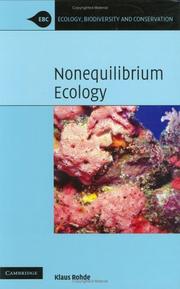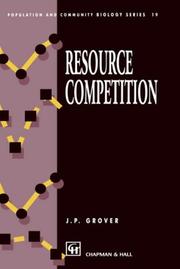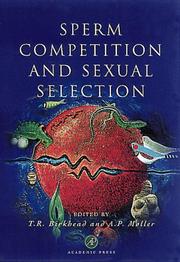| Listing 1 - 5 of 5 |
Sort by
|

ISBN: 9780511542152 9780521854344 9780521674553 0511137559 9780511137556 0511133979 9780511133978 0511542151 9780511135385 0511135386 0521854342 0521674557 1107155037 9781107155039 1280431768 9781280431760 9786610431762 6610431760 0511183682 9780511183683 0511201753 9780511201752 0511311869 9780511311864 Year: 2005 Publisher: Cambridge, UK New York Cambridge University Press
Abstract | Keywords | Export | Availability | Bookmark
 Loading...
Loading...Choose an application
- Reference Manager
- EndNote
- RefWorks (Direct export to RefWorks)
Ecology has long been shaped by ideas that stress the sharing of resources and the competition for those resources, and by the assumption that populations and communities typically exist under equilibrium conditions in habitats saturated with both individuals and species. However, much evidence contradicts these assumptions and it is likely that nonequilibrium is much more widespread than might be expected. This book is unique in focusing on nonequilibrium aspects of ecology, providing evidence for nonequilibrium and equilibrium in populations (and metapopulations), in extant communities and in ecological systems over evolutionary time, including nonequilibrium due to recent and present mass extinctions. The assumption that competition is of overriding importance is central to equilibrium ecology, and much space is devoted to its discussion. As communities of some taxa appear to be shaped more by competition than others, an attempt is made to find an explanation for these differences.
Ecology. --- Competition (Biology) --- Biotic competition --- Ecological competition --- Interspecific competition --- Intraspecific competition --- Species competition --- Struggle for survival (Biology) --- Survival, Struggle for (Biology) --- Population biology --- Species --- Balance of nature --- Biology --- Bionomics --- Ecological processes --- Ecological science --- Ecological sciences --- Environment --- Environmental biology --- Oecology --- Environmental sciences --- Ecology
Book
ISBN: 9780199376377 9780199376407 Year: 2017 Publisher: New York : Oxford University Press,
Abstract | Keywords | Export | Availability | Bookmark
 Loading...
Loading...Choose an application
- Reference Manager
- EndNote
- RefWorks (Direct export to RefWorks)
The topic of women’s competition has gained significant recent momentum. This book provides direct evidence of this growth and is the first scholarly volume to focus specifically on the topic. In general, the included chapters provide a definitive view of the current state of knowledge regarding women’s competition. Many of the chapters are theoretically grounded in an evolutionary framework, such that the authors investigate the adaptive nature of women’s competitive behavior, motivations, and cognitions. Other chapters rely on a different framework, with these authors instead arguing that sociocultural sources shape women's competition. In addition, while the book is primarily about women, some contributors focus their chapters on issues faced by adolescent girls, or mention developmental trajectories for young girls through to adulthood. Some authors focus on nonhuman females to provide a stronger background for understanding women. It is hoped that the information within this volume will serve as a source of inspiration to help guide future directions for research
Women --- Competition (Psychology) --- Psychology. --- Sexual attraction --- Sex appeal --- Sexiness --- Sexual attractiveness --- Interpersonal attraction --- Biotic competition --- Ecological competition --- Interspecific competition --- Intraspecific competition --- Species competition --- Struggle for survival (Biology) --- Survival, Struggle for (Biology) --- Competitive behavior --- Competitiveness (Psychology) --- Competition (Biology) --- Mate selection --- Human females --- Wimmin --- Woman --- Womon --- Womyn --- Psychology --- E-books --- Courtship --- Dating (Social customs) --- Interpersonal relations --- Man-woman relationships --- Marriage brokerage --- Population biology --- Species --- Conflict (Psychology) --- Motivation (Psychology) --- Females --- Human beings --- Femininity

ISBN: 0412749300 1461379393 1461563976 9780412749308 Year: 1997 Volume: 19 Publisher: London Chapman and Hall
Abstract | Keywords | Export | Availability | Bookmark
 Loading...
Loading...Choose an application
- Reference Manager
- EndNote
- RefWorks (Direct export to RefWorks)
As one of the most quantitative of ecological subdisciplines, resource competition is an important, central area of ecology. Recently research into this area has increased dramatically and resource competition models have become more complex. The characterisation of this phenomenon is therefore the aim of this book. Resource Competition seeks to identify the unifying principles emerging from experimental and theoretical approaches as well as the differences between organisms, illustrating that greater knowledge of resource competition will benefit human and environmental welfare. This book will serve as an indispensable guide to ecologists, evolutionary biologists and environmental managers, and all those interested in resource competition as an emerging discipline.
Competition (Biology) --- 574.3 --- 574.2 --- 574 --- Biotic competition --- Ecological competition --- Interspecific competition --- Intraspecific competition --- Species competition --- Struggle for survival (Biology) --- Survival, Struggle for (Biology) --- Population biology --- Species --- Populations and environment. Population dynamics --- Organisms and environment. Habitat. Preferendum --- General ecology. Biocoenology. Hydrobiology. Biogeography --- 574 General ecology. Biocoenology. Hydrobiology. Biogeography --- 574.2 Organisms and environment. Habitat. Preferendum --- 574.3 Populations and environment. Population dynamics --- Evolutionary biology. --- Ecology . --- Zoology. --- Evolutionary Biology. --- Ecology. --- Biology --- Natural history --- Animals --- Balance of nature --- Bionomics --- Ecological processes --- Ecological science --- Ecological sciences --- Environment --- Environmental biology --- Oecology --- Environmental sciences --- Animal evolution --- Biological evolution --- Darwinism --- Evolutionary biology --- Evolutionary science --- Origin of species --- Evolution --- Biological fitness --- Homoplasy --- Natural selection --- Phylogeny --- Ecology
Book
ISBN: 128358414X 0520954041 9780520954045 0520274180 9780520274181 9781283584142 9780520274181 Year: 2012 Publisher: Berkeley : University of California Press,
Abstract | Keywords | Export | Availability | Bookmark
 Loading...
Loading...Choose an application
- Reference Manager
- EndNote
- RefWorks (Direct export to RefWorks)
Evolutionary biology has long sought to explain how new traits and new species arise. Darwin maintained that competition is key to understanding this biodiversity and held that selection acting to minimize competition causes competitors to become increasingly different, thereby promoting new traits and new species. Despite Darwin's emphasis, competition's role in diversification remains controversial and largely underappreciated. In their synthetic and provocative book, evolutionary ecologists David and Karin Pfennig explore competition's role in generating and maintaining biodiversity. The authors discuss how selection can lessen resource competition or costly reproductive interactions by promoting trait evolution through a process known as character displacement. They further describe character displacement's underlying genetic and developmental mechanisms. The authors then consider character displacement's myriad downstream effects, ranging from shaping ecological communities to promoting new traits and new species and even fueling large-scale evolutionary trends. Drawing on numerous studies from natural populations, and written for a broad audience, Evolution's Wedge seeks to inspire future research into character displacement's many implications for ecology and evolution.
Animal diversity. --- Competition (Biology) --- Divergence (Biology) --- Biotic competition --- Ecological competition --- Interspecific competition --- Intraspecific competition --- Species competition --- Struggle for survival (Biology) --- Survival, Struggle for (Biology) --- Population biology --- Species --- Biology --- Phylogeny --- Animal biodiversity --- Animal biological diversity --- Animals --- Diversity, Animal --- Faunal diversity --- Zoological diversity --- Biodiversity --- Diversity --- biodiversity. --- biographical. --- biology books. --- books for science lovers. --- conservation of environment. --- darwin theories. --- discussion books. --- easy to read. --- ecological communities. --- educational books. --- engaging. --- environmental ecology. --- evolution of biology. --- evolution of science. --- food chain. --- going green. --- history. --- home school science books. --- learning from experts. --- leisure reads. --- life sciences. --- maintaining biodiversity. --- nonfiction books. --- protecting animals. --- scientists. --- the importance of the environment. --- travels books.

ISBN: 0121005437 9780121005436 9780080541594 0080541593 1281054070 9781281054074 9786611054076 Year: 1998 Publisher: San Diego Academic Press
Abstract | Keywords | Export | Availability | Bookmark
 Loading...
Loading...Choose an application
- Reference Manager
- EndNote
- RefWorks (Direct export to RefWorks)
Sperm Competition and Sexual Selection presents the intricate ways in which sperm compete to fertilize eggs and how this has prompted reinterpretations of breeding behavior. This book provides a theoretical framework for the study of sperm competition, which is a central part of sexual selection. It also discusses the roles of females and the relationships between paternal care in sperm competition. The chapters focusing on taxonomic development are diverse and cover all the major animal groups, both vertebrate and invertebrate, and plants. The final chapter provides an overview discuss
Evolution. Phylogeny --- Sexual reproduction --- Semen --- Biological competition --- Sexual behaviour --- Natural selection --- Spermatozoa --- Sexual behavior in animals --- Competition (Biology) --- Sexual selection in animals --- Spermatozoïdes --- Comportement sexuel chez les animaux --- Compétition (Biologie) --- Sélection sexuelle chez les animaux --- Spermatozoa. --- Sexual behavior in animals. --- Sexual selection in animals. --- Male gametes --- Sperm --- Gametes --- Animals, Sexual selection in --- Biotic competition --- Ecological competition --- Interspecific competition --- Intraspecific competition --- Species competition --- Struggle for survival (Biology) --- Survival, Struggle for (Biology) --- Population biology --- Species --- Animals --- Breeding behavior --- Copulation behavior in animals --- Copulation in animals --- Copulatory behavior in animals --- Copulatory pattern (Animal behavior) --- Mating behavior --- Reproductive behavior --- Sex behavior in animals --- Animal behavior --- Sexual behavior --- ro: ed. by
| Listing 1 - 5 of 5 |
Sort by
|

 Search
Search Feedback
Feedback About UniCat
About UniCat  Help
Help News
News